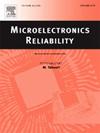Localization of heavy doping missing defect in MOSFET by the combined use of nanoprobing analysis and SCM technique
IF 1.6
4区 工程技术
Q3 ENGINEERING, ELECTRICAL & ELECTRONIC
引用次数: 0
Abstract
The paper demonstrates an effective flow to localize heavy doping missing defect accurately in failed metal-oxide-semiconductor field-effect transistor (MOSFET). It is commonly known that it is not feasible to localize rare doping anomaly and further visualize the corresponding less doped regions in MOSFET relying on ordinary transmission electron microscopy (TEM) analysis since the dopant distribution is not detectable for TEM. Nevertheless, we found that this kind of defect can be isolated by the combined use of nanoprobing analysis and scanning capacitance microscopy (SCM) technique. The combinational solution was rarely reported before. Nanoprobing analysis of transfer characteristic of failed MOSFET confirms the on-state current drop by two orders of magnitude. Next, the contacting state at source and drain region of MOSFET is examined. Current-voltage (I-V) characteristic of source and drain p-n junctions indicates that high contact resistance comes from metal-semiconductor interface change from ohmic contact to rectifying contact unexpectedly. Eventually, intensive analysis of SCM data proves that tungsten plugs touch lightly doped silicon so that the outcome leads to the formation of Schottky junction that owns rectifying I-V characteristic. In contrast, the tungsten plug touching heavily doped silicon produces ohmic contact, so it keeps normal I-V characteristic of p-n junction. Energy-band theory explains that I-V characteristic of metal-semiconductor interface is closely related to doping concentration in silicon since it determines the potential barrier width at interface where mobile carrier transport phenomenon occurs. The potential barrier width increases as the doping concentration decreases in the silicon side of the interface. We conclude that lack of heavy doping in MOSFET source and drain areas is responsible for high contact resistance. In the article, we present several practical examples to show accurate localization of heavy doping missing defect in different PMOS and NMOS. Furthermore, unwanted over-etching of tungsten plug hole caused MOSFET failure is also studied since it looks quite like heavy doping missing induced electrical fault. Our study promotes the understanding of failure mechanism about heavy doping missing defect in MOSFET of diverse mainstream technology nodes.
结合纳米探针分析和单片机技术定位MOSFET中重掺杂缺失缺陷
本文给出了一种精确定位失效金属氧化物半导体场效应晶体管(MOSFET)中重掺杂缺失缺陷的有效流程。众所周知,由于普通透射电子显微镜(TEM)无法检测到掺杂分布,因此依靠普通透射电子显微镜(TEM)分析无法定位MOSFET中罕见的掺杂异常并进一步可视化相应的低掺杂区域。然而,我们发现这种缺陷可以通过纳米探针分析和扫描电容显微镜(SCM)技术的结合来分离。组合解决方案以前很少有报道。对失效MOSFET转移特性的纳米探测分析证实了导通电流下降了两个数量级。其次,研究了MOSFET源极和漏极的接触状态。源极和漏极p-n结的电流-电压(I-V)特性表明,高接触电阻来自金属-半导体界面从欧姆接触到整流接触的意外变化。最后,通过对单片机数据的深入分析,证明钨插头与轻掺杂硅接触,从而形成具有整流I-V特性的肖特基结。相比之下,钨塞接触重掺杂硅时产生欧姆接触,因此保持p-n结正常的I-V特性。能带理论解释了金属-半导体界面的I-V特性与硅中掺杂浓度密切相关,因为它决定了发生移动载流子输运现象的界面处的势垒宽度。界面硅侧掺杂浓度越低,势垒宽度越宽。我们得出结论,在MOSFET源极和漏极区域缺乏重掺杂是高接触电阻的原因。在本文中,我们给出了几个实际的例子来展示在不同的PMOS和NMOS中重掺杂缺失缺陷的精确定位。此外,不必要的钨插头孔的过度蚀刻引起的MOSFET故障也进行了研究,因为它看起来很像重掺杂缺失感应电故障。我们的研究促进了对不同主流技术节点MOSFET中重掺杂缺失缺陷失效机制的理解。
本文章由计算机程序翻译,如有差异,请以英文原文为准。
求助全文
约1分钟内获得全文
求助全文
来源期刊

Microelectronics Reliability
工程技术-工程:电子与电气
CiteScore
3.30
自引率
12.50%
发文量
342
审稿时长
68 days
期刊介绍:
Microelectronics Reliability, is dedicated to disseminating the latest research results and related information on the reliability of microelectronic devices, circuits and systems, from materials, process and manufacturing, to design, testing and operation. The coverage of the journal includes the following topics: measurement, understanding and analysis; evaluation and prediction; modelling and simulation; methodologies and mitigation. Papers which combine reliability with other important areas of microelectronics engineering, such as design, fabrication, integration, testing, and field operation will also be welcome, and practical papers reporting case studies in the field and specific application domains are particularly encouraged.
Most accepted papers will be published as Research Papers, describing significant advances and completed work. Papers reviewing important developing topics of general interest may be accepted for publication as Review Papers. Urgent communications of a more preliminary nature and short reports on completed practical work of current interest may be considered for publication as Research Notes. All contributions are subject to peer review by leading experts in the field.
 求助内容:
求助内容: 应助结果提醒方式:
应助结果提醒方式:


